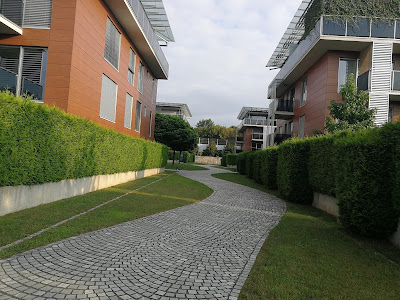by Mateja Mihinjac
Winter influences how we use our neighbourhood. Because of short daylight hours and cold weather, walking the neighbourhood is often an isolating experience. Current COVID lockdowns all across the world make these changes even more pronounced. All this affects the perception of safety of local residents, especially regarding residential laneways that may become risky movement predictors.
RESIDENTIAL LANEWAYS
Residential laneways, also called alleys, back lanes or catwalks, are a welcome addition to the neighbourhood when they provide accessibility, shorten travel paths, and enhance walkability. They can serve as positive places for interaction.
Some blame these micro-places for increasing opportunities for crime. Research suggests that laneways can facilitate crime opportunities by contributing to increased levels of noise, property crime, antisocial behaviour and fear.
Yet others argue that laneway research shows improvements in social and environmental sustainability, which lead to better safety and perception of safety outcomes. Positive laneway design has a buffering effect on crime and vulnerable targets due to increased informal social controls stemming from higher levels of social cohesion.
Therefore, the question is not whether laneways have a place in the neighbourhood because they might trigger crime opportunities – laneways have many positive attributes that contribute to walkability and neighbourhood liveability. Rather the question should be how do we better design laneways and make them safe.
POOR DESIGN
Many laneways are separated from neighbouring courtyards with high non-permeable fences that offer few opportunities for natural surveillance and interaction. Such laneways create tunnel-like gauntlets that are unattractive, especially at night.
In addition to this, many laneways, especially in North America, are positioned along backyard residential garage areas intended predominantly for vehicles and rubbish removal. No wonder these laneways become a “no man’s land” and thus lead to safety concerns described earlier.
One of our project teams from a recent Calgary SafeGrowth training identified that residents were concerned with hiding spots, poor visibility in the dark, graffiti on tall fencing, and similar. Clearly, laneway designers must create open and attractive areas that pay attention to pedestrian use.
IT’S MORE THAN CRIME
The second issue is that the laneway debate centres exclusively around crime prevention. Little attention is given to larger issues such as the type of the laneway and neighbourhood structure. Conversely, much of urban design literature speaks to the importance of integrating multiple liveability indicators and considering safety as an integral rather than isolated indicator of laneway suitability. As architecture professor Kim Dovey says, “I begin from the view that the urban public realm needs to be at once safe, accessible, vital, creative and democratic.”
Criminologist Paul Cozens believes that when the discussion centres around crime prevention alone, we make laneways hostile to human-scale design. In fact, he claims we can inadvertently “design in crime” while the residents become isolated from one another and from the outside neighbourhood.
When our Calgary team spoke to residents they found that the residents often referred to other quality of life concerns that affected their use of the laneways rather than safety concerns alone. Some of these included poor maintenance, tripping hazards, poor wayfinding, and integration of laneways with the street.
Again, this suggests we must consider laneways more holistically, not strictly with a crime prevention eye, and we must reconcile safety with other liveability indicators.
WHAT CAN BE DONE?
Despite the potential safety risks, there are many benefits of well-designed and well-functioning residential laneways. If designed well, they can further enhance community capacity-building and create a sense of neighbourhood.
There are some excellent toolkits describing how to accomplish these goals. They include a Turning Laneways into Public Places document and a Reimagine Catwalks Playbook.
As we say repeatedly in SafeGrowth, what matters most is collaborative design with residents – not designing to or for them. This is how we use laneways, not as dreadful shortcuts and fear-inducing places, but as shortcuts for building the neighbourhood.





Research shows in The Netherlands these back allies to be a burglary problem indeed. These allies are rather small in the Netherlands mainly for the purpose of garbage removal, acces for the fire brigade in case of emergency and of course for bringing your bike to the shet in the garden. Requirements are e.g. available in the Dutch police label safe and secure housing. See K4 page 30 and byond here: https://www.politiekeurmerk.nl/wp-content/uploads/2019/10/191015-Nieuwbouw_los.pdf (it's all about light, width, material, colour etc. But also the pattern of these allies within a block (max 20 houses connected e.g.)
ReplyDeleteThe Reimagine Catwalks Playbook is gold! It really demonstrates taking catwalks from being lost/problematic spaces to beloved parts of a neighbourhood.
ReplyDeleteIt certainly is a great resource, Dimitri, and offers some great actionable ideas. We loved the catwalks team's project!
ReplyDeleteThanks,
Mateja
Thank you for your comment and the resource, Paul. I've also come across many "problematic" laneways. But it doesn't have to be like that! We have several tools that can help us address existing and potential issues, including the one you shared with us. Many thanks!
ReplyDelete